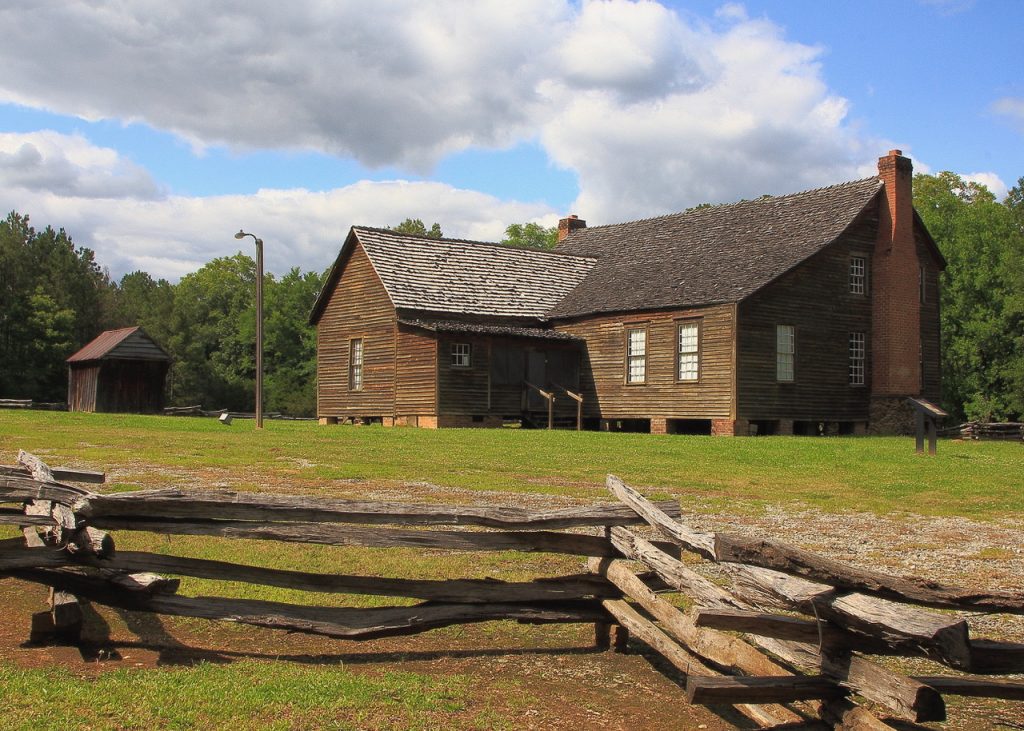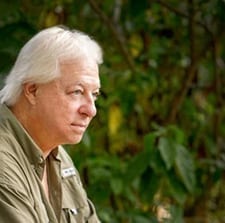Bonham House—Last Of Its Kind
May 9, 2024By Tom Poland
In Saluda County an old homeplace sits on brick piers. It’s as solid as the Rock of Gibraltar, but that wasn’t always the case. Some refer to the old homeplace as Flat Grove. Some the Bonham House. If I told you it’s the last surviving birthplace of an Alamo hero, would you believe me?
On a warm afternoon I made my way down a back road to the Bonham House. I can’t speak for you, but I have a love-hate affair with GPS. It’s rendered me helpless. I just listen to a recorded voice and drive. After a good many twists and turns I found the place. Thank you, all-knowing traffic director.

A singular landmark, restored by the Saluda County Historical Society.
Right off I saw the old split rail fence. “This place is the real deal.” Ignore the lighting and historical marker and you’re in the 1770s. That homeplace. It’s as close as I’ll ever get to the Alamo, a memory from boyhood. Through dust piled high by years gone by, the boy in me recalls an old Disney show about Davey Crockett and the Alamo. I idolized Crockett, so much so that my grandmother made me a coonskin hat. I don’t think she put a real coon tail on it but it’s possible. Granddad had a penchant for possum. He probably killed a few raccoons too.
Coon or possum, little did I know I grew up one hour from a real hero of the Alamo. Twice James Butler Bonham made it through Mexican’s line to get help for his beleaguered comrades. Twice he slipped back through the lines to the Alamo, knowing he was returning to his death.
For near fifty years I’ve driven down Highway 378 minutes from Bonham’s birthplace. Jacob Smith built Flat Grove in the 1770s, a dogtrot cabin of hand-hewn, heart-pine logs covered by clapboards. In 1807 James Butler Bonham, Jacob Smith’s grandson, came into this world in that cabin. He would die at the Alamo March 6, 1836, while manning a cannon in the Alamo chapel. No other birthplace of an Alamo exists save this sturdy cabin.
In Saluda a saying goes, “Texas Starts Here.” Saluda County is the birthplace and childhood home of another Alamo hero, William Barret Travis. The letter Travis wrote from the Alamo February 24, 1836, “Victory or Death!,” is one of the most famous documents in Texas history. In 2016 Historians Jack Meyer and Bettis Rainsford on public radio said the prospect of land and a natural inclination to fight led Bonham and Travis to Texas and the Alamo.
At one time Bonham’s birthplace was in dire straits. Thank the Saluda County Historical Society for restoring this historic home. Visit this historic home, and remember the Alamo and James Butler Bonham (an attorney) and William Barret Travis. They and 180 men in a Spanish mission held an army of 5,000 at bay for thirteen days. Imagine far away San Antonio and cannon fire, smoke, and the cries of men as guns fire and swords clash in this pivotal battle of the Texas Revolution.
Two footnotes: According to the Texas State Historical Association, Bonham was born in what was Edgefield District at that time.
Bonham, Texas, honors Saluda County’s hero. In 1936 the Texas Centennial Commission erected a statue of Bonham on Bonham’s courthouse square. Not bad for a lawyer found in contempt of court in 1830 after caning an opposing attorney. When the judge ordered Bonham to apologize he refused and threatened to tweak the judge’s nose—a strange retort that earned him ninety days in jail.
Georgia native Tom Poland writes a weekly column about the South, its people, traditions, lifestyle, and culture and speaks frequently to groups in the South. Governor Henry McMaster conferred the Order of the Palmetto upon Tom, South Carolina’s highest civilian honor, stating, “His work is exceptional to the state.” Poland’s work appears in books, magazines, journals, and newspapers throughout the South.
Visit Tom’s website at www.tompoland.net
Email him at [email protected]














